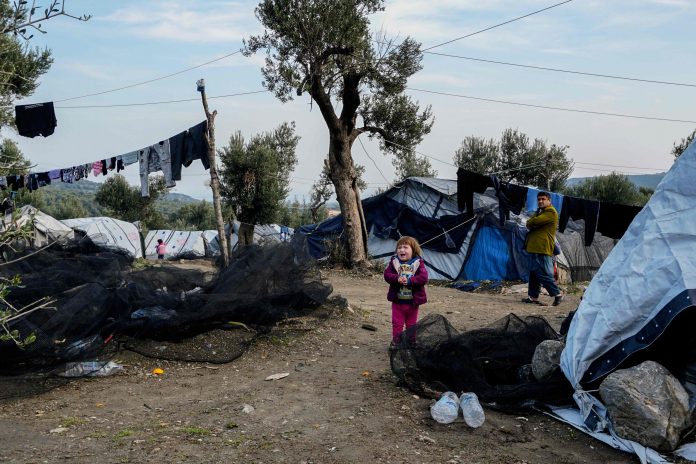Forlag: Pluto Press (Storbritannien)
(THIS ARTICLE IS MACHINE TRANSLATED by Google from Norwegian)
In September 2015, the image of Alan Kurdi went around the world. The three-year-old Syrian boy was found dead on the beach at the Turkish city of Bodrum, and it put a heavy focus on the entire refugee flow that was moving from the Turkish coast to Europe at the time.
This is too close, it cannot possibly happen here with us, was a common reaction among Europeans. The refugee problem had suddenly been given a face with a name, so it was difficult to distance itself from it anymore. One had to decide.

2015 was the record year. More than a million people arrived in Europe and the flow of refugees had shifted. In the first months of the year, most of the Mediterranean came on the route from Libya to the island of Lampedusa and southern Italy. Several boats sank along the way, and many drowned. From April that year, the refugees began to come through Turkey, and in large numbers they landed on the Greek island of Lesbos. This is where the third phase of this development began when the EU and Turkey agreed in March 2016 to regulate the flow of refugees, leading to Lesbos becoming one of the European so-called hotspots.
The ruptured dream

Four researchers from British universities visited Lesbos over several times during this chaotic era, and it has turned into a captivating story titled New Borders.
They emphasize that the book is neither about the refugees nor the flow of refugees, which is really the main story and the real tragedy; it has already been extensively described in the media and a wide range of books. The authors, on the other hand, take the changes in European border policy for analytical consideration and it has turned into a slightly flattering picture.
Border control has helped to make refugees a perceived threat, and this is in keeping with the spirit of Brexit and Trump and the extreme right wing's desire for isolationism.
Formally, the idea of hotspots is to streamline the reception of refugees by bringing together a strip of European Union agencies under one hat. The book, however, points to a less so appealing page, and it lies in the paradigm shift that is in fact the case. The classic migration starts with the desire for better life somewhere else. The reasons may be many, but the goal is the same. It is a vision or a dream that is accomplished as the migrant arrives at the physical goal. It is a process where a threshold is exceeded and the new life opens. With the changed policy, this threshold has disappeared and the refugee has been placed in a permanent state of uncertainty. Now it is no longer about respect for freedom of movement, but about control.
Permanent mobility
A little popular was said in the past that a migrant could come in if he had good teeth and the urine test dropped out favorably. Right up to the beginning of 2015, the Greek authorities made minimal efforts to register the refugees. Neighboring Macedonia included the refugees, on condition that they had traveled further north over 72 hours, so that the desired goal could be reached in, for example, Germany in a few days.
The individual refugee has been individualized because he or she has been deprived of the community and is no longer seen as the representative of a cause.
Then came the "little white houses" that a taxi driver on Lesbos calls the facility, which in a very short time became the detention camp. Initially, the four scientists could come and go as they please, but soon they were supposed to be admitted. And the camp's refugees, or now asylum seekers, had to wait until they were distributed around the continent by unexplained quota schemes, and they could no longer wish where they wanted to go. Most often the trip just went on to another temporary stay. The book describes this permanent mobility as a deliberate policy, preventing refugees from socializing and starting to make collective demands. It is compared to certain low cost airlines that constantly rotate cabin crew from crew to crew to avoid personal friendships and the desire to organize.

(PHOTO: NTB SCANPIX / AFP)
Institutionalized violence
This represents a tremendous avalanche of 1990s visions of a world without borders, and it is a dramatic downturn for globalization. The individual refugee has been individualized because he or she has been deprived of the community and is no longer seen as the representative of a cause. As a result, the popular interest and sympathy of Europeans has plunged.
The relationship is illustrated beautifully through two examples. After the Greco-Turkish War 1919-22, a border was drawn down through the Aegean Sea, and from both sides of the new border people moved "home". Thus, a very large part of the population of Lesbos originated from the Greek minority on the Turkish mainland and on that occasion moved to the island. In other words, the locals know the existence of refugees, but in the old-fashioned way, and this is the explanation that the current refugee flow never led to reluctance to the travelers – even though they were at ten times as many as the local Greeks.

The other counterpart is the Danish-Swedish border, where in May 2017 the border control was reintroduced. It was entirely in line with official European policy. The purpose was to control the freedom of movement of refugees and the result was that the local people saw how their presence made life difficult for ordinary citizens. It has helped to make refugees a perceived threat, and it is fully in line with the spirit of Brexit and Trump and the extreme right wing's desire for isolationism – and the globalization of globalization. It is not without reason that the authors of the book describe the phenomenon of hotspots as institutionalized violence.






